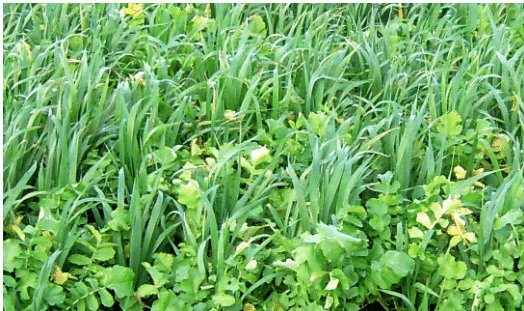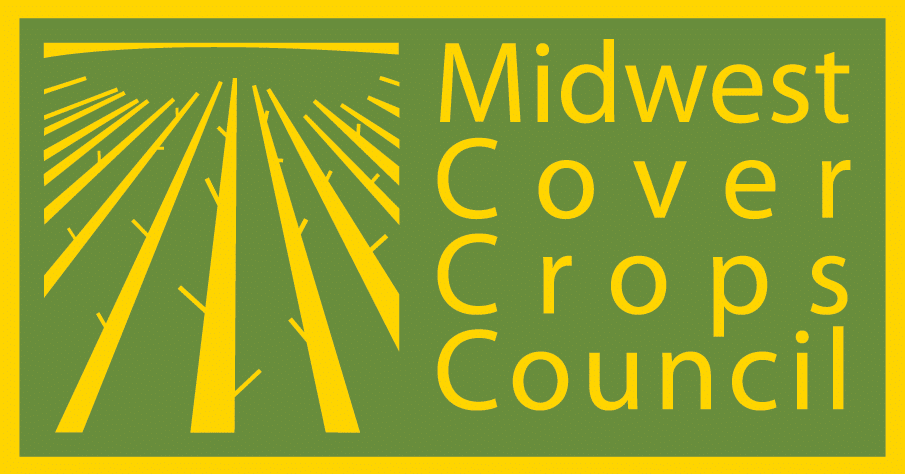Midwest Cover Crops Council (MCCC-138)
Purdue Extension (AY-368-W)
This publication is intended to provide a starting point for farmers who are new to growing cover crops. With experience, farmers may fine-tune the use of cover crops for their systems.
Introduction
The following recipe provides an introductory approach to integrating a cover crop into a wheat rotation with soybean or corn. Planting oat and daikon-type radish cover crops after wheat (see Figure 1) and ahead of a soybean or corn cash crop is an easy way to introduce cover crops into your rotation because these cover crops both winter-kill and add important diversity to agricultural fields.
Planning and Preparation
- Planning—Educate yourself. Start small. Be timely. Prioritize management based on your purpose and objectives.
- Wheat variety and planting—No modifications to wheat variety and planting are required for the successful use of cover crops after wheat harvest.
- Residual wheat herbicides—Oats and radish are tolerant of most herbicides applied to the wheat crop in-season before flag leaf emergence. However, if the cover crop will be grazed or fed to livestock, there may be restrictions on herbicide use. See herbicide label for specific instructions.
- Seed purchase—Order cover crop seed early from a reputable seed dealer. Purchasing named varieties is preferred to buying variety not stated (VNS) seed. Important traits such as vegetative growth rate, cold and heat tolerance, disease resistance, or insect resistance of named varieties are known, whereas little is known about those traits with VNS seed. A general goal for a mix planted at this time is for it to remain vegetative and growing biomass late into fall or until it is terminated by freezing temperatures. For cover crop radishes (daikon-type), be sure to purchase a single variety since mixed varieties may have unpredictable emergence or bolt to flower immediately and produce seed rather than producing the desired large amounts of biomass and roots. Purchasing VNS oat seed will be less of a risk when obtaining it from a reputable dealer if it has been cleaned, tested for germination, and has a seed tag.
Summer/Fall Work
- Wheat harvest—Harvest wheat at the normal time in fields where a mix of oats and radish will be planted. If residue levels are high, consider removing straw. If straw is not harvested, cut the wheat high or use a stripper header and make sure that the combine distributes straw and chaff evenly across the swath.
- Planting time—Plant oats and radish anytime in August after wheat harvest and after any other field activities such as manure application or tile installation. Planting a cool-season annual, such as radish, prior to August is not recommended as it may result in flowering and seed production instead of quick coverage and biomass accumulation, which is the desired goal for this cover crop. Use the Cover Crop Selector Tool for precise seeding dates for your county.
- Planting method—Drill or plant radish and oats in narrow rows to a depth of 0.50–1.00 inch, depending on moisture, or broadcast with light incorporation. Note that disturbance of the soil, if any, should be light since excessive disturbance of wheat stubble may reduce cover crop benefits. Light tillage will likely synchronize volunteer wheat and cover crop emergence. Emerged winter wheat will overwinter and need to be terminated before corn or soybean seeding occurs the following spring.
- Seeding rate in oats/radish mix—Mix seeds prior to planting at the following rates (pure live seed, drilled or broadcast): oats, 18–36 lbs./acre; radish, 1–2 lbs./acre. Adjustments to your mix ratio can be made to customize to your specific situation. A higher rate of oats and lower rate of radish is recommended for highly erodible soils and areas sensitive to phosphorus loss. When radishes winter-kill, they will make the soil more erodible and release phosphorus. If you are planning to plant corn in the spring, a higher rate of radish as compared to oats is advised to lower the carbon-to-nitrogen (C:N) ratio of the residue.
- Tillage or no-tillage—Under most circumstances, it is easy for no-till planters to achieve excellent seed placement in the winter-terminated residues. If tillage is used, it is usually better to wait until spring in order to maintain surface cover to prevent erosion.
- Fertility or liming—If applying P, K, lime, or manure, complete the application, injection, and/or incorporation prior to seeding or apply to the growing oats and radish before the ground freezes. It is not advised to apply manure at seeding as high salt levels can result in poor germination. If injecting manure, low-disturbance injectors are available that will minimize damage to oats and radish. Surface application of liquid manure on top of the cover crop is not recommended. Surface broadcast of dry manure or litter should be done prior to seeding, but 4 tons or less can be applied to growing oats and radish with minimal damage provided it is evenly distributed.

Spring Work
- Starter fertilizer—No modifications to your typical fertilization program are required for planting soybean or corn after oats and radish use.
- Termination—Oats and radish should both terminate by winterkill. However, mild winters and good snow cover sometimes allow radish to overwinter. If this occurs, radishes are easily terminated with typical pre-plant herbicide applications.
- Soybean or corn planting—It is usually best to no-till plant cash crops into the dead/dry or standing cover crop. Almost all modern planters and drills are fully capable of planting soybean or corn into an oat and radish cover crop. In some cases, the radish tuber will swell enough to cause soil heaving and/or leave holes following the desiccation of the tuber. By cash-crop planting time, this is seldom a no-till planting issue, particularly if the planter is equipped with row cleaners. Check planter attachments and settings such as row cleaners, closing wheels, and down pressure shortly after beginning to plant into the cover crop residue as some adjustments are usually needed for uniform seed depth, seed furrow closure, and ultimately, seedling emergence.
- Scouting—After soybean or corn planting, scout for crop emergence and population. Additionally, scout for weeds since cover crop residue can often delay emergence of annual weeds, which may delay the application of post-emergence herbicides.
Resources
Cover Crop Selector Tool —available from the Midwest Cover Crops Council
Residual Herbicides and Fall Cover Crop Establishment (Purdue Extension Weed Science publication)
Authors
Anna Morrow, Midwest Cover Crops Council; Shalamar Armstrong, Keith Johnson, Eileen Kladivko, and Dan Quinn, Purdue University (Note: This publication was adapted with consent from MCCC under a joint project to produce customized introductory guidance about cover crops for all member states/provinces.)
Reviewer and Contributor
Barry Fisher, retired USDA–Natural Resources Conservation Service, Fisher Soil Health
The Midwest Cover Crops Council (www.midwestcovercrops.org) aims to facilitate widespread adoption of cover crops throughout the Midwest by providing educational/outreach resources and programs, conducting new research, and communicating about cover crops to the public.
Funding for this project was provided by McKnight Foundation.
December 2022
The U.S. Department of Agriculture (USDA) prohibits discrimination in all its programs and activities on the basis of race, color, national origin, age, disability, and where applicable, sex, marital status, familial status, parental status, religion, sexual orientation, genetic information, political beliefs, reprisal, or because all or a part of an individual’s income is derived from any public assistance program. (Not all prohibited bases apply to all programs.) Persons with disabilities who require alternative means for communication of program information (Braille, large print, audiotape, etc.) should contact USDA’s TARGET Center at (202) 720-2600 (voice and TDD). To file a complaint of discrimination write to USDA, Director, Office of Civil Rights, 1400 Independence Avenue, S.W., Washington, D.C. 20250-9410 or call (800) 795-3272 (voice) or (202) 720-6382 (TDD). USDA is an equal opportunity provider and employer. ©2022 by MCCC. All rights reserved.
